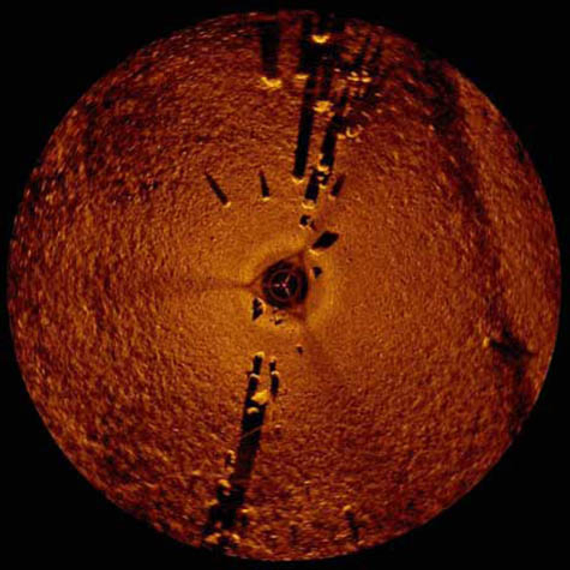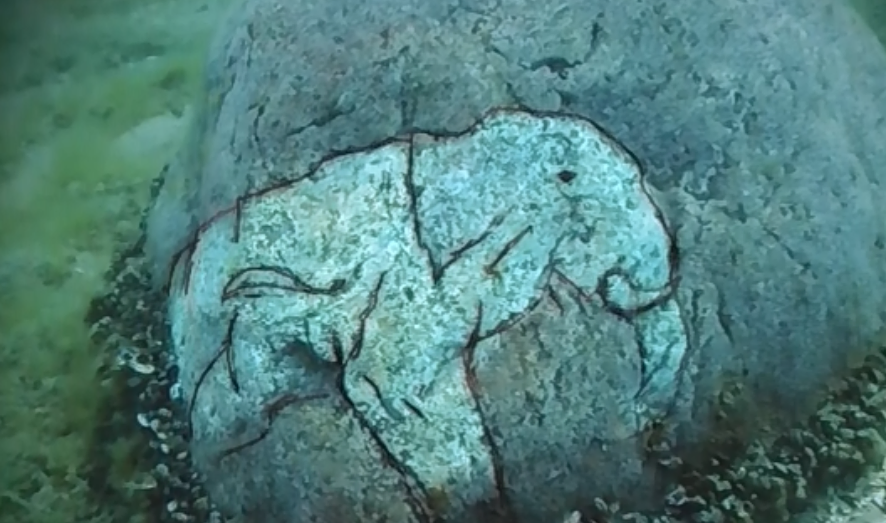Grand Traverse Bay, renowned for its calm waters and maritime legacy, hides a fascinating past beneath its surface. Over the years, explorers have uncovered numerous shipwrecks that reflect the bay’s significance as a hub for 19th and 20th-century trade. Now, a groundbreaking discovery is adding a prehistoric twist to its historical narrative.
Dr. Mark Holley, an underwater archaeology professor at Northwestern Michigan University, has unveiled an ancient structure beneath the bay. Dubbed by some as “Michigan’s Stonehenge,” this discovery is sparking intrigue and reshaping perspectives on the region’s distant past.
The structure lies about 40 feet below the surface of Lake Michigan. While smaller than its namesake in England, the stones are carefully arranged, suggesting intentional placement. Stretching over a mile, the stones vary in size—from basketball-like dimensions to as large as compact cars—forming a sinuous line.
One stone, in particular, has captured the spotlight. Measuring 3.5 to 4 feet tall and 5 feet wide, it bears a carving of a mastodon, offering a glimpse into a time when these ancient creatures roamed the area. This remarkable artifact bridges the gap between human history and the prehistoric world, deepening the mysteries of Grand Traverse Bay.

The stones are estimated to be around 9,000 years old, predating Stonehenge by about 4,000 years. This period follows the end of the Ice Age and the formation of Grand Traverse Bay, when the lake bed had not yet been submerged.
Stretching 32 miles in length and 12 miles in width, Grand Traverse Bay is nestled in the northeastern arm of Lake Michigan, bordered by Michigan’s lower peninsula. Known for its underwater shipwreck dive sites, the bay attracts tourists who come to explore these sunken vessels with snorkels and fins.
The exact location of the Stonehenge-like structure remains a closely guarded secret. After his discovery, Dr. Holley informed the Grand Traverse Band of Ottawa and Chippewa tribes to show respect for their ancestral heritage and protect the site from damage. Consequently, the coordinates of this archaeological wonder are not disclosed to the public.
The submerged nature of the stones poses a significant challenge for archaeologists. Since their discovery in 2007, progress in studying the site has been slow, leading to widespread speculation about its significance. Researchers have looked to other regional stone formations for potential correlations, hoping to unravel the secrets of these underwater stones.
Similar stone structures in the vicinity provide tantalizing clues about the purpose of the Grand Traverse Bay arrangement. Dr. John O’Shea from the University of Michigan has studied a rock formation in Lake Huron, dating back 9,000 years.
Situated 120 feet below the surface along the Alpena-Amberley Ridge, this stone assemblage is believed to have been used for ancient hunting practices, possibly to channel caribou.
Beaver Island, the largest island in Lake Michigan, also holds ancient stone formations. On the island’s west side, along the Reddings Trail, a circle of glacial boulders is found, some marked with inscriptions. One stone even features a carved hole, suggesting it had a functional use.

Although formal analyses like carbon dating are lacking, these stones are thought to have been significant to the Native American communities that once inhabited the island, possibly serving as calendrical markers or celestial observation points.
The purpose of the Grand Traverse Bay stone arrangement remains speculative. It could have been used by ancient caribou hunters, similar to the Lake Huron formation, or it might have served as an ancient calendar, aligning with celestial events like Stonehenge. The ambiguity highlights the need for further research and analysis, which is complicated by the underwater setting.
As technology advances, new methods of underwater exploration and analysis emerge, bringing us closer to understanding these ancient structures. Each discovery adds to our knowledge of the past, allowing us to glimpse the lives and practices of those who lived thousands of years ago.

In the coming years, the secrets of Grand Traverse Bay are likely to unfold further, providing invaluable insights into prehistoric life and the ancient peoples who once called this region home. Through meticulous research and respectful preservation, we honor their memory and enrich our understanding of the world’s ancient past.
Note: Materials provided above by The Brighter Side of News. Content may be edited for style and length.
Like these kind of feel good stories? Get The Brighter Side of News’ newsletter.
The post Archeologists discover 9000-year-old ‘Stonehenge-like’ structure in Lake Michigan appeared first on The Brighter Side of News.